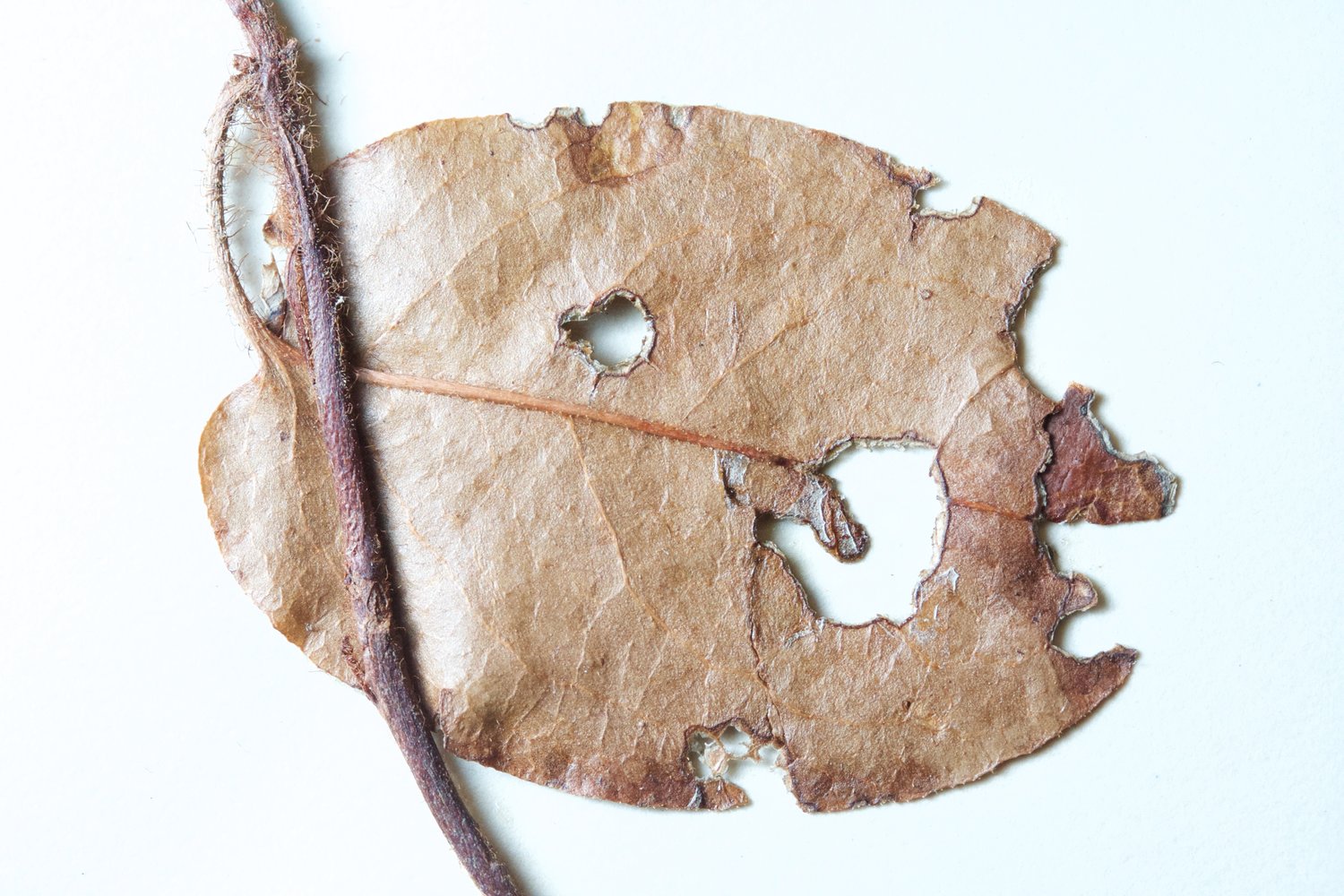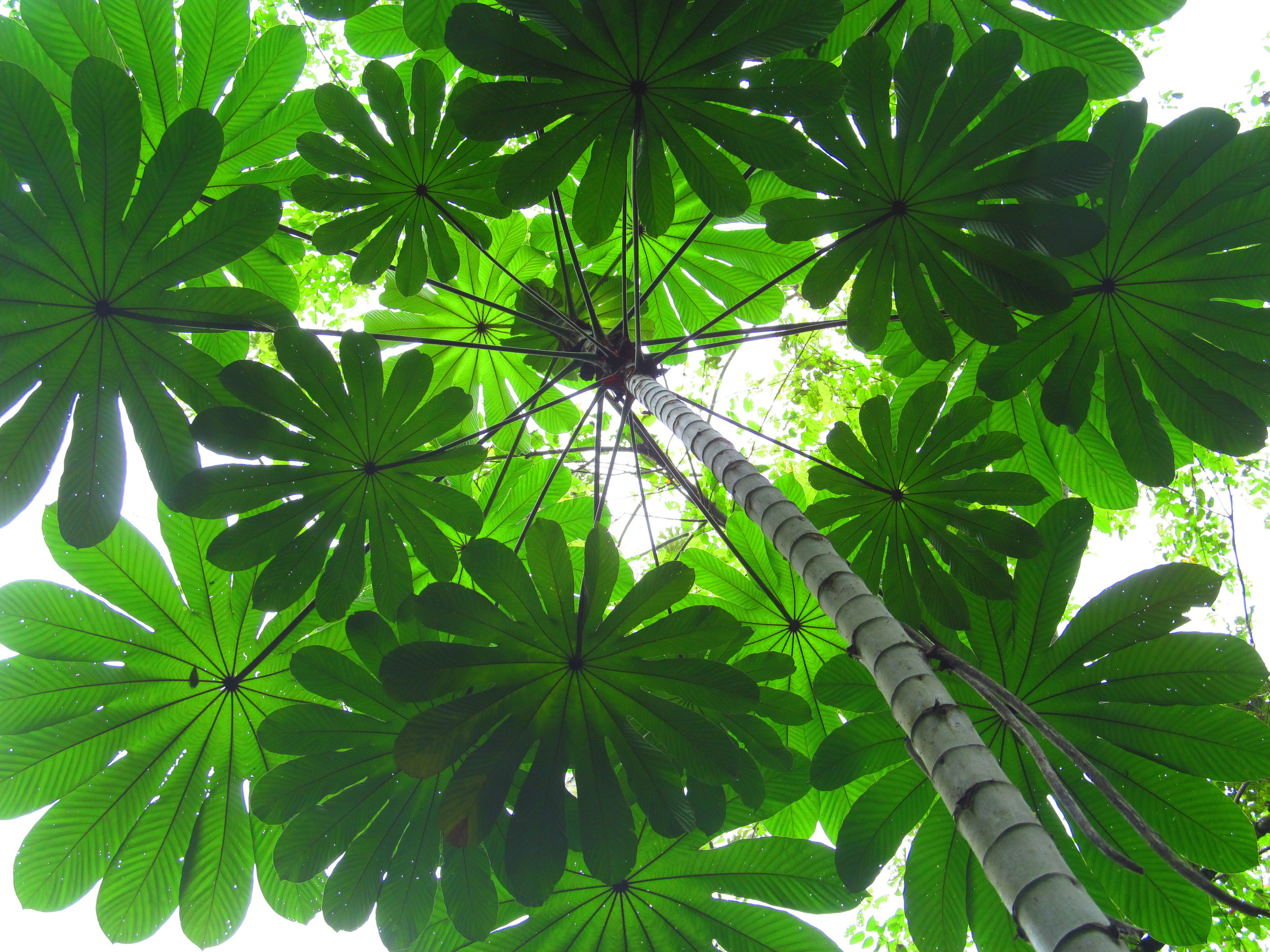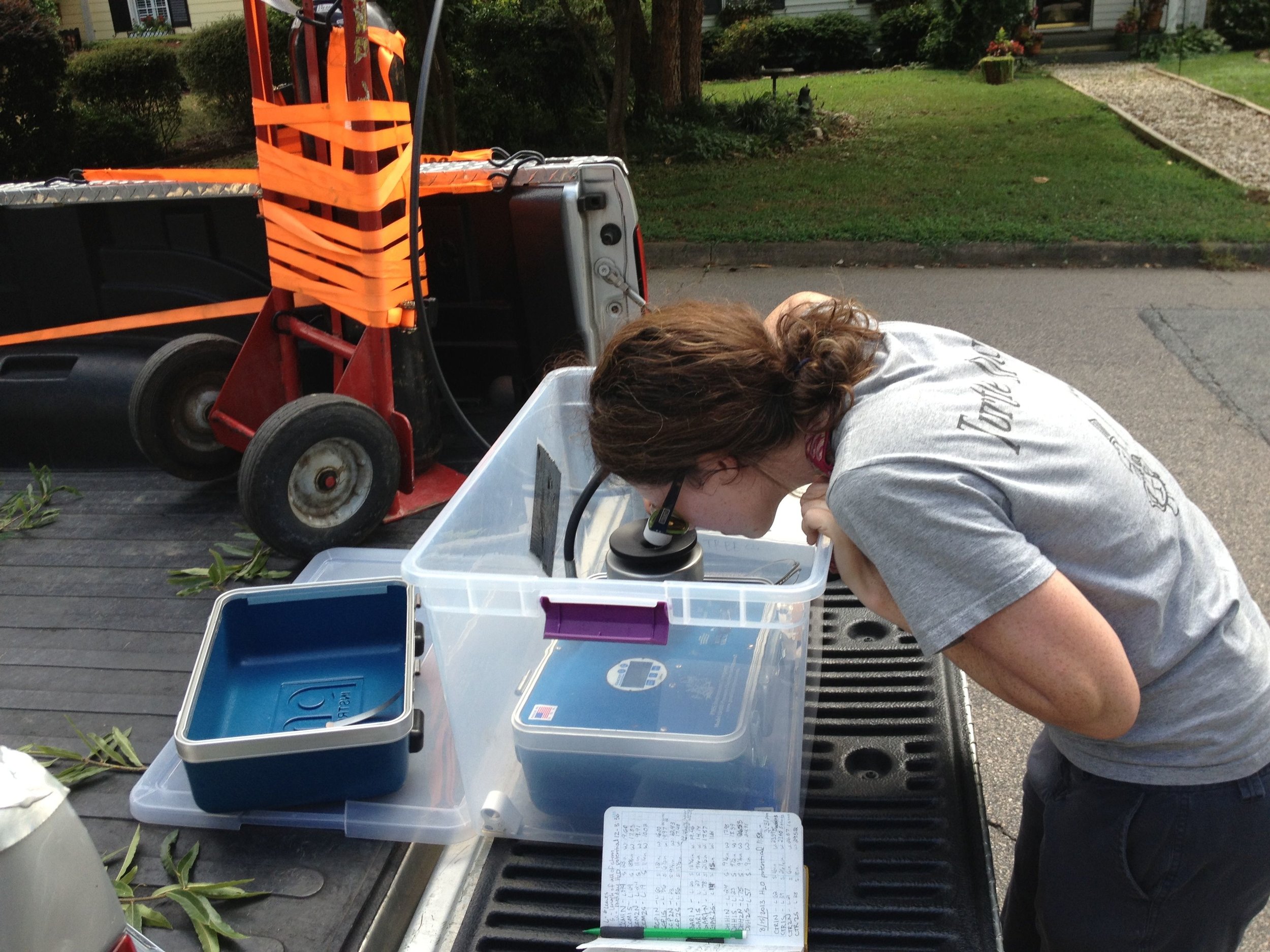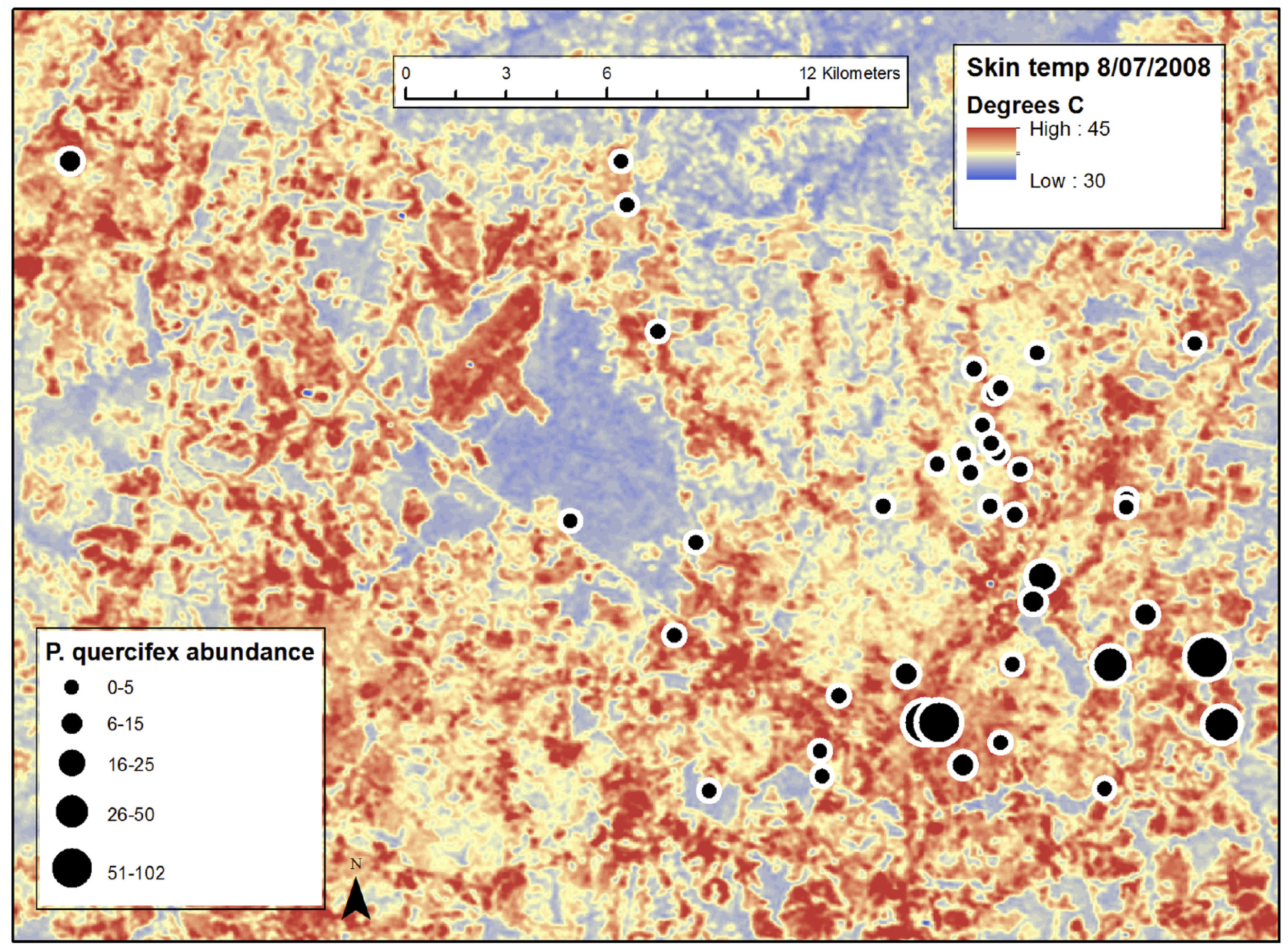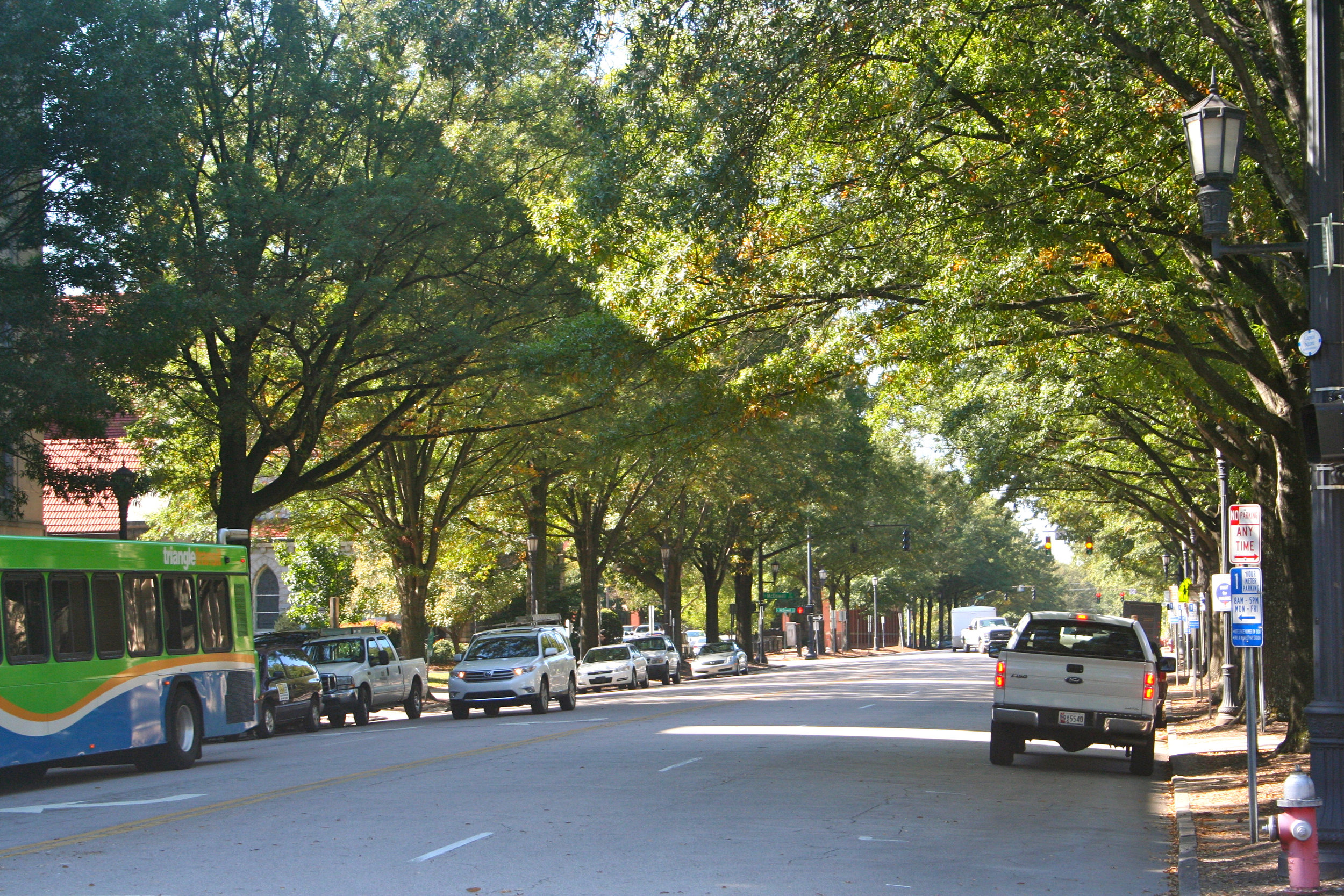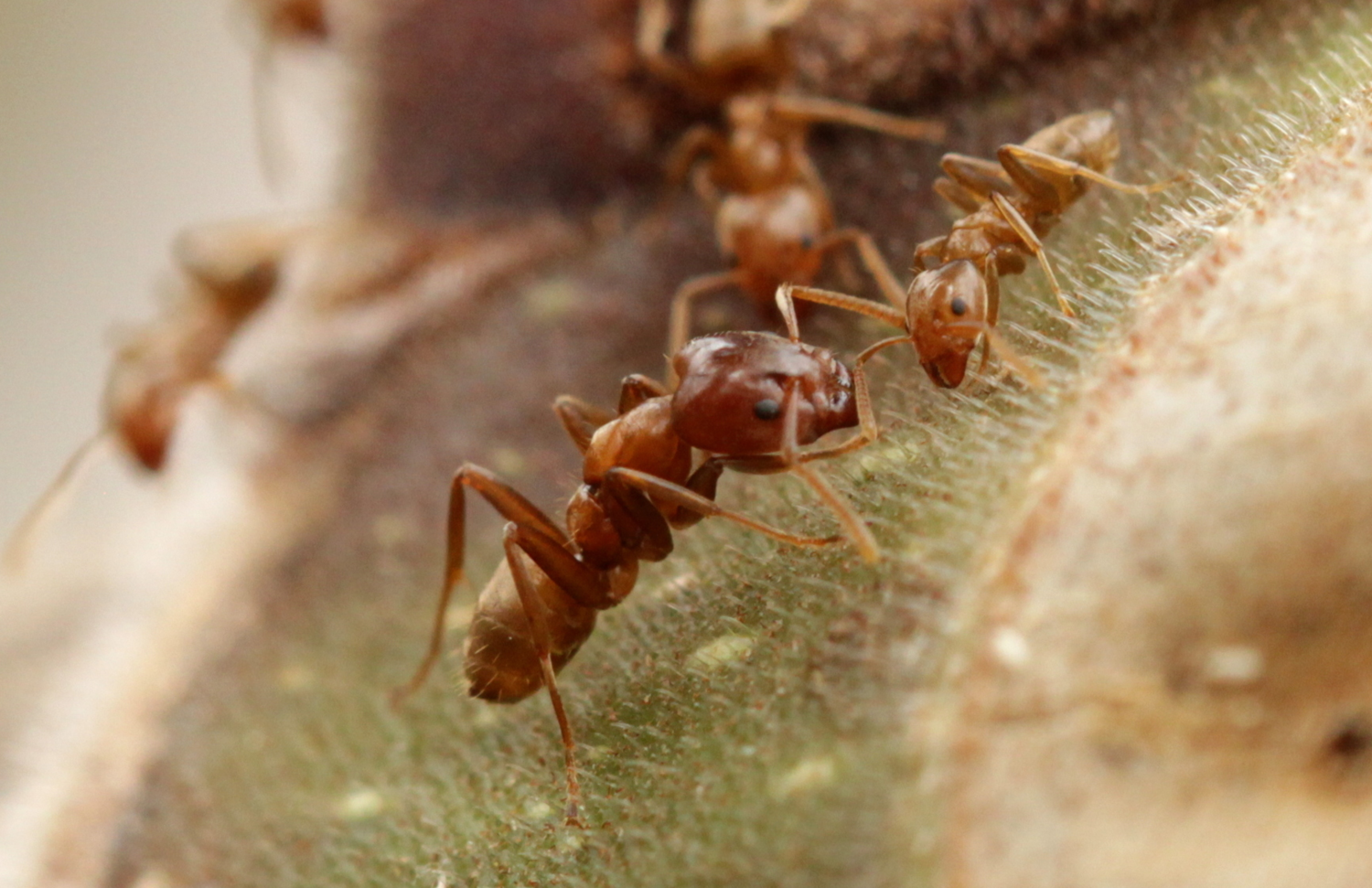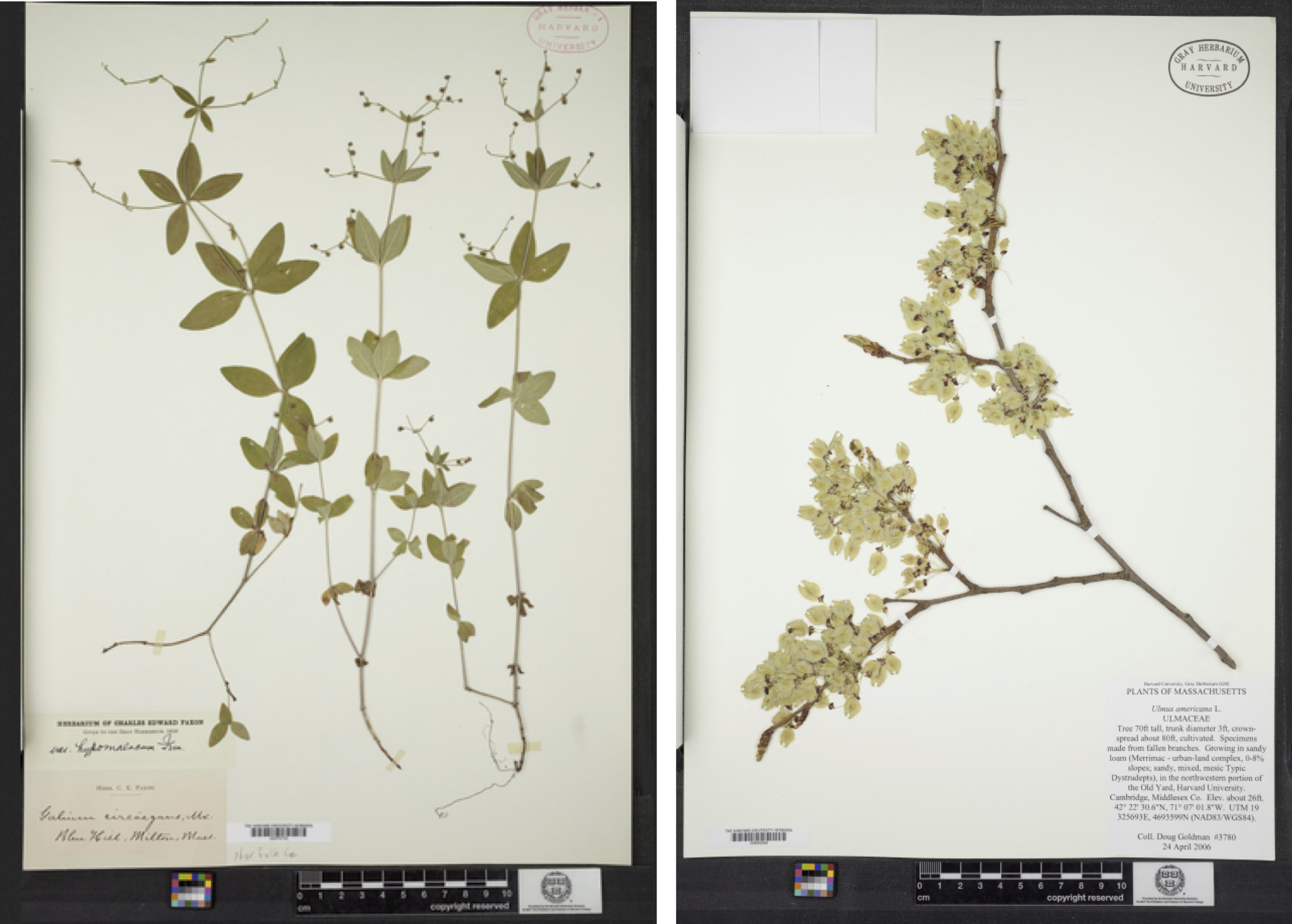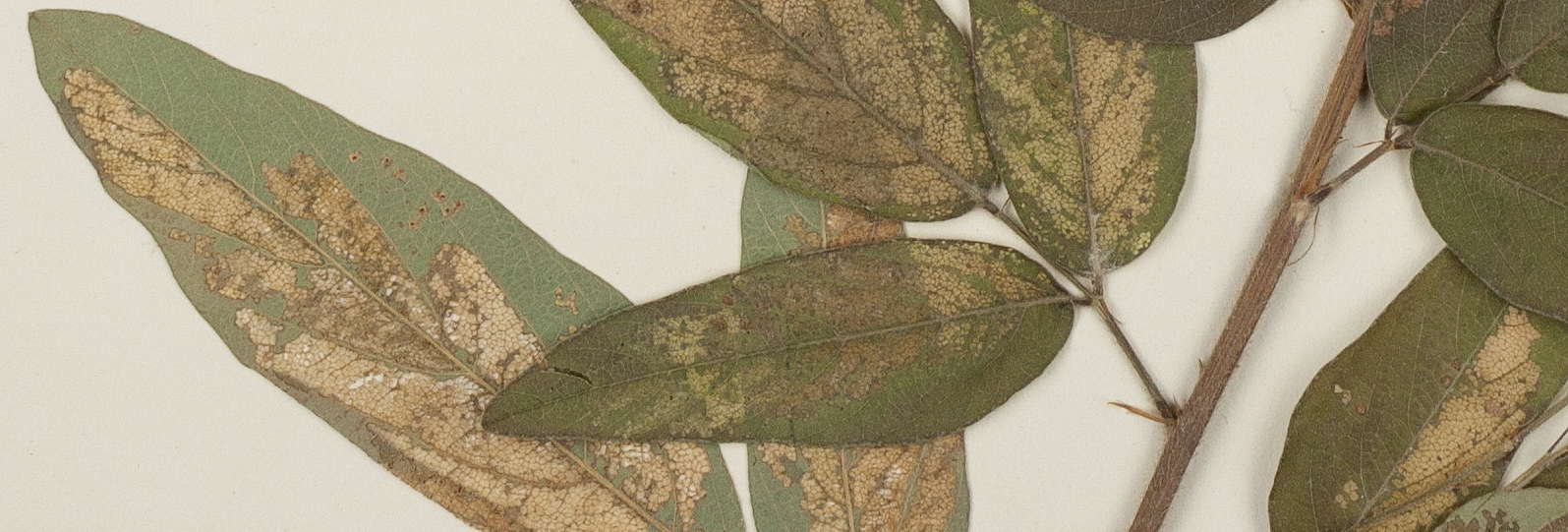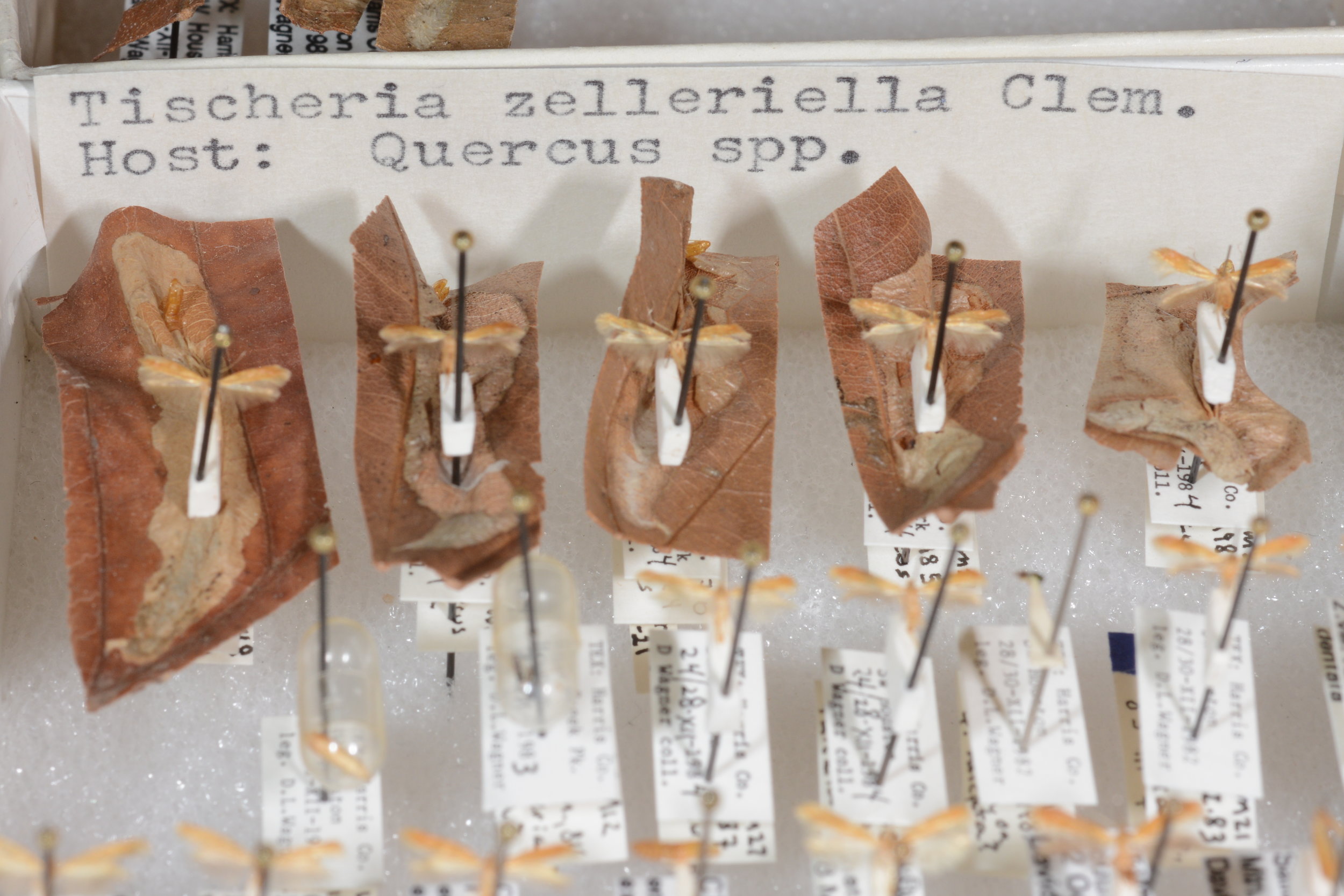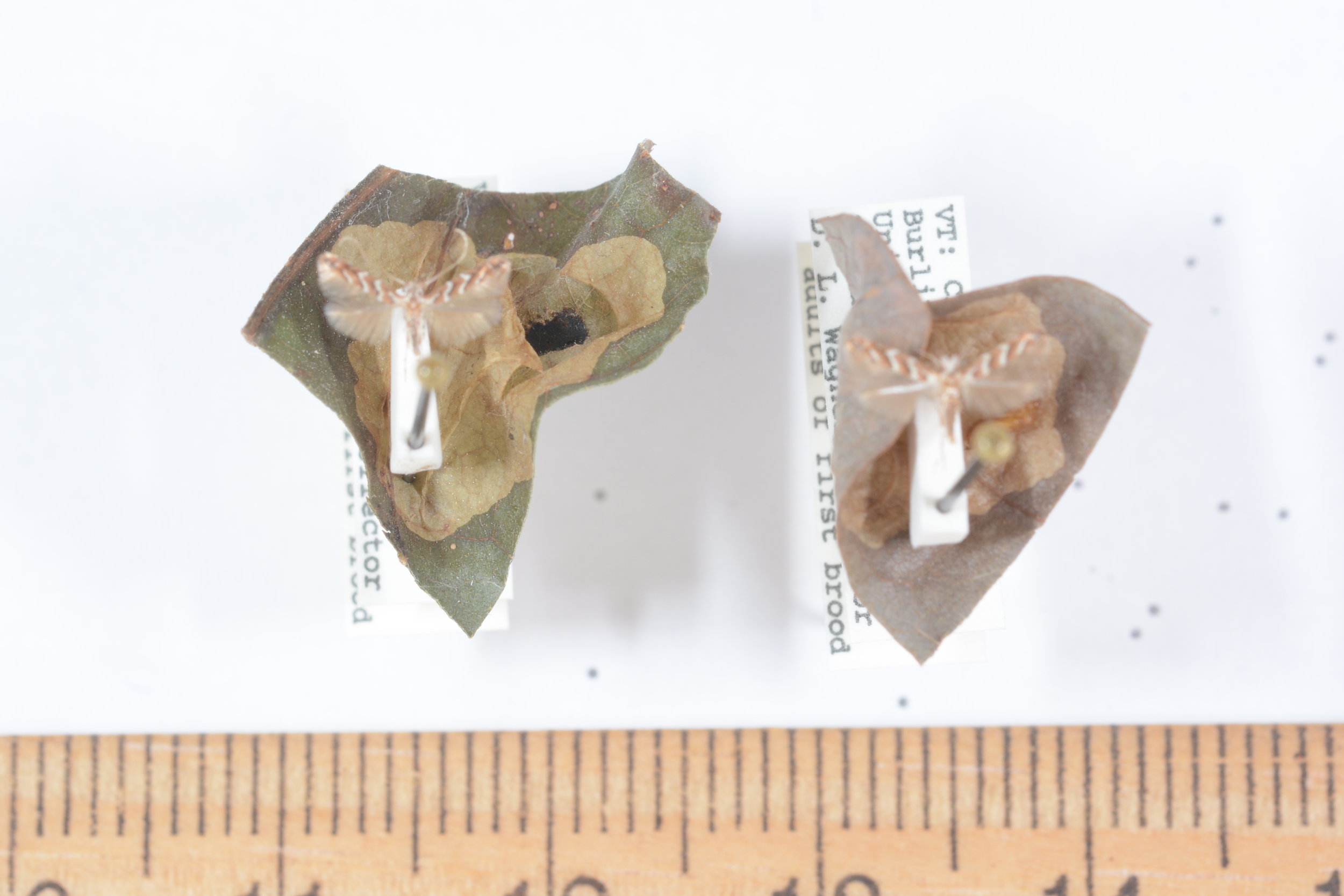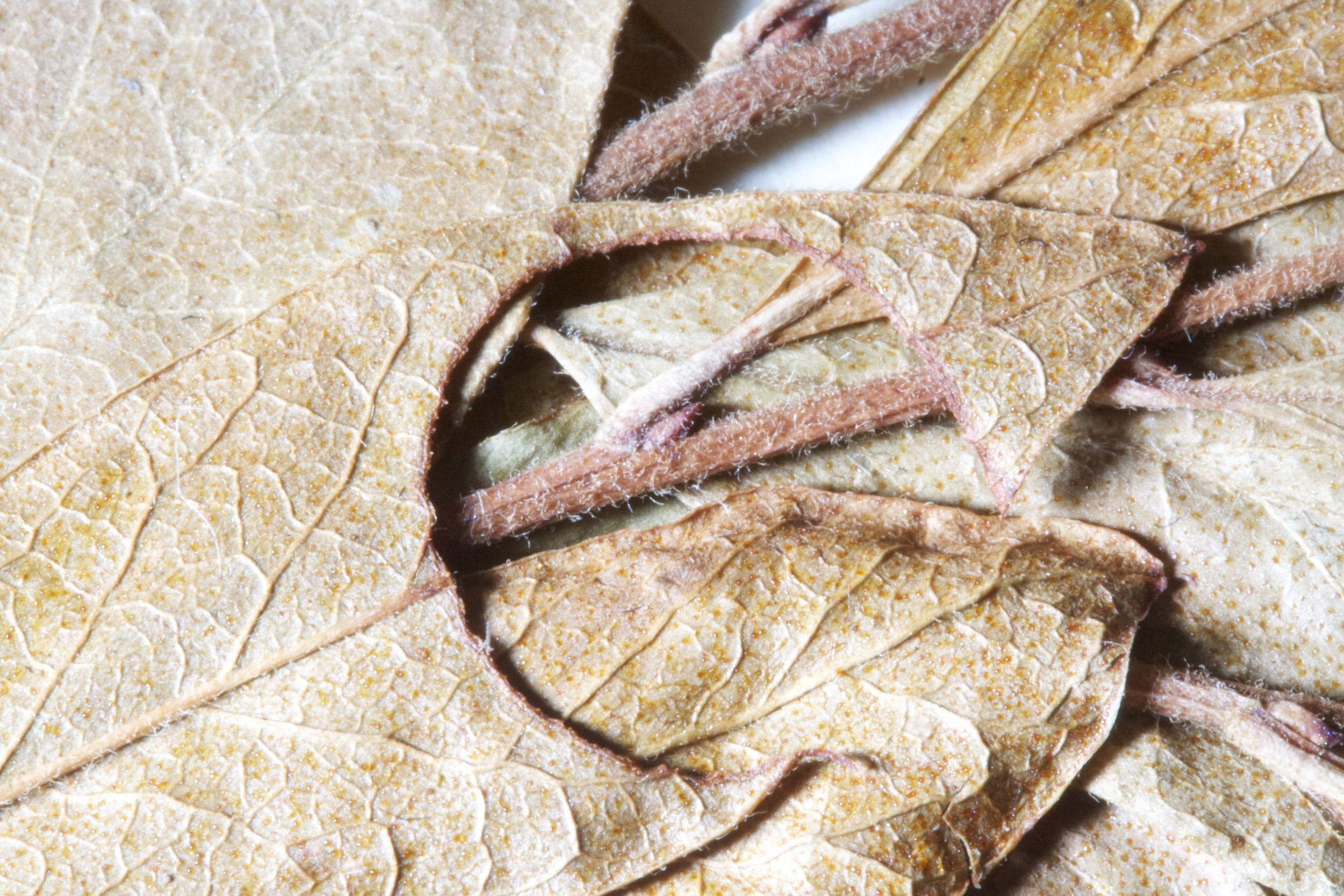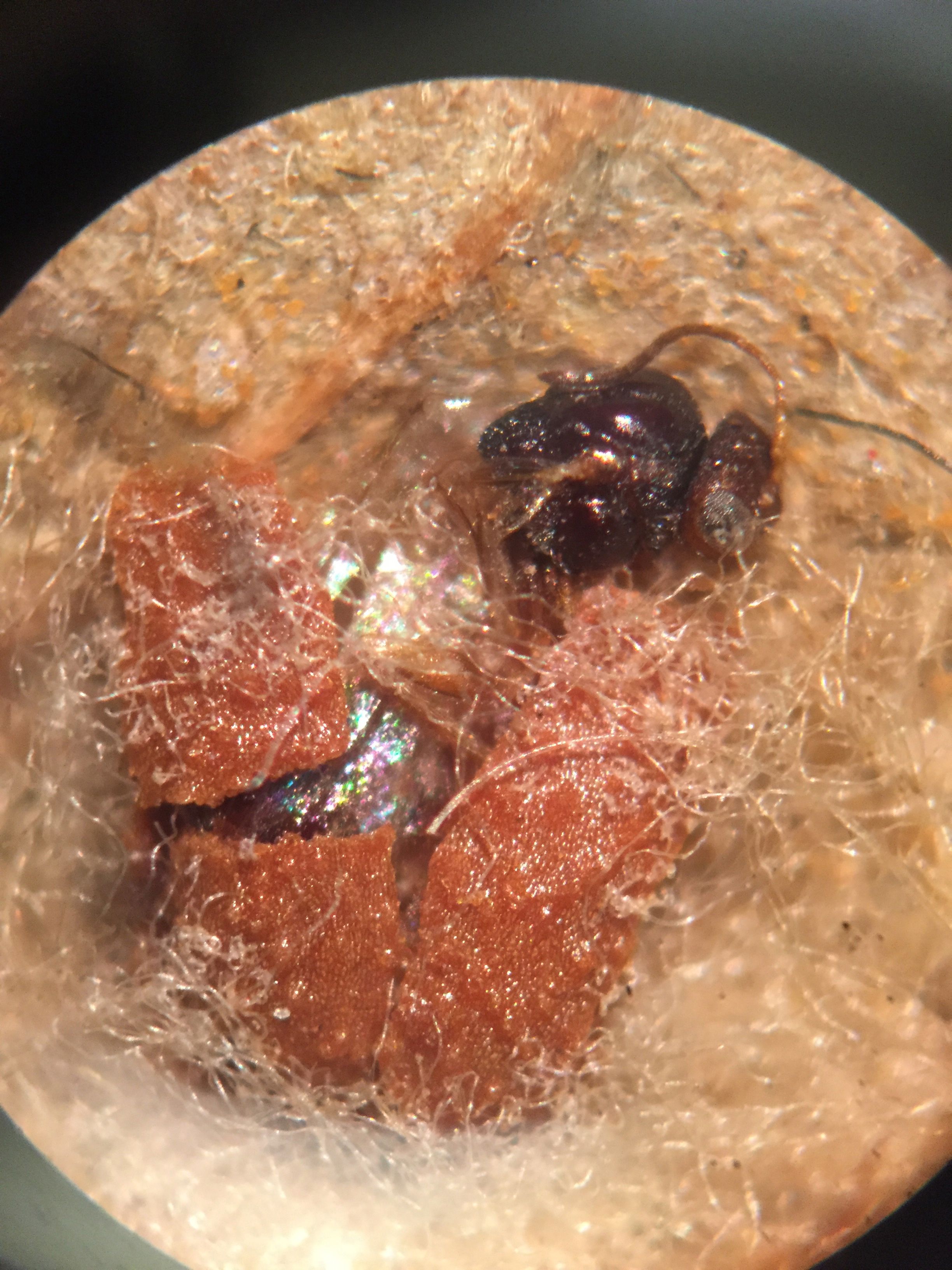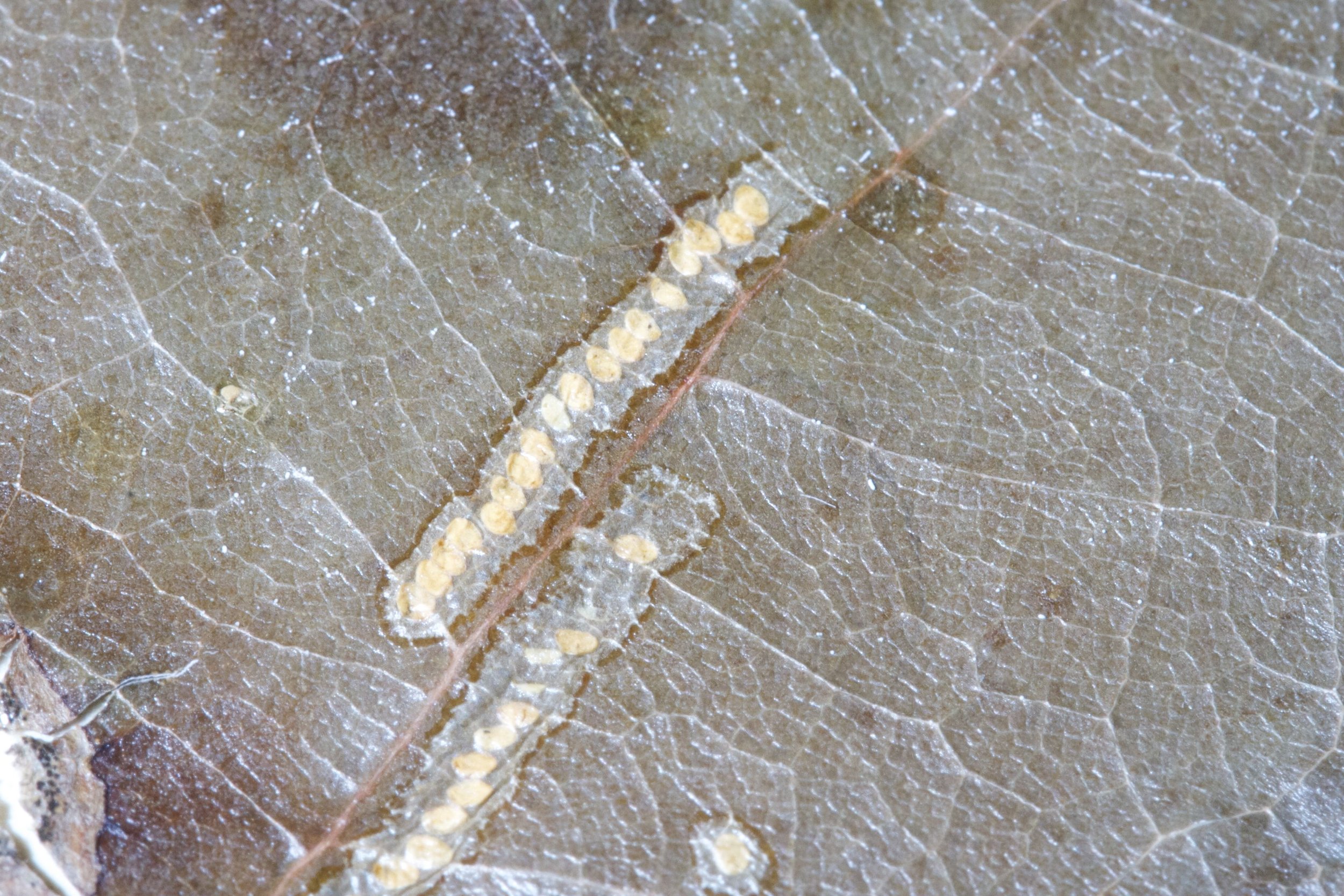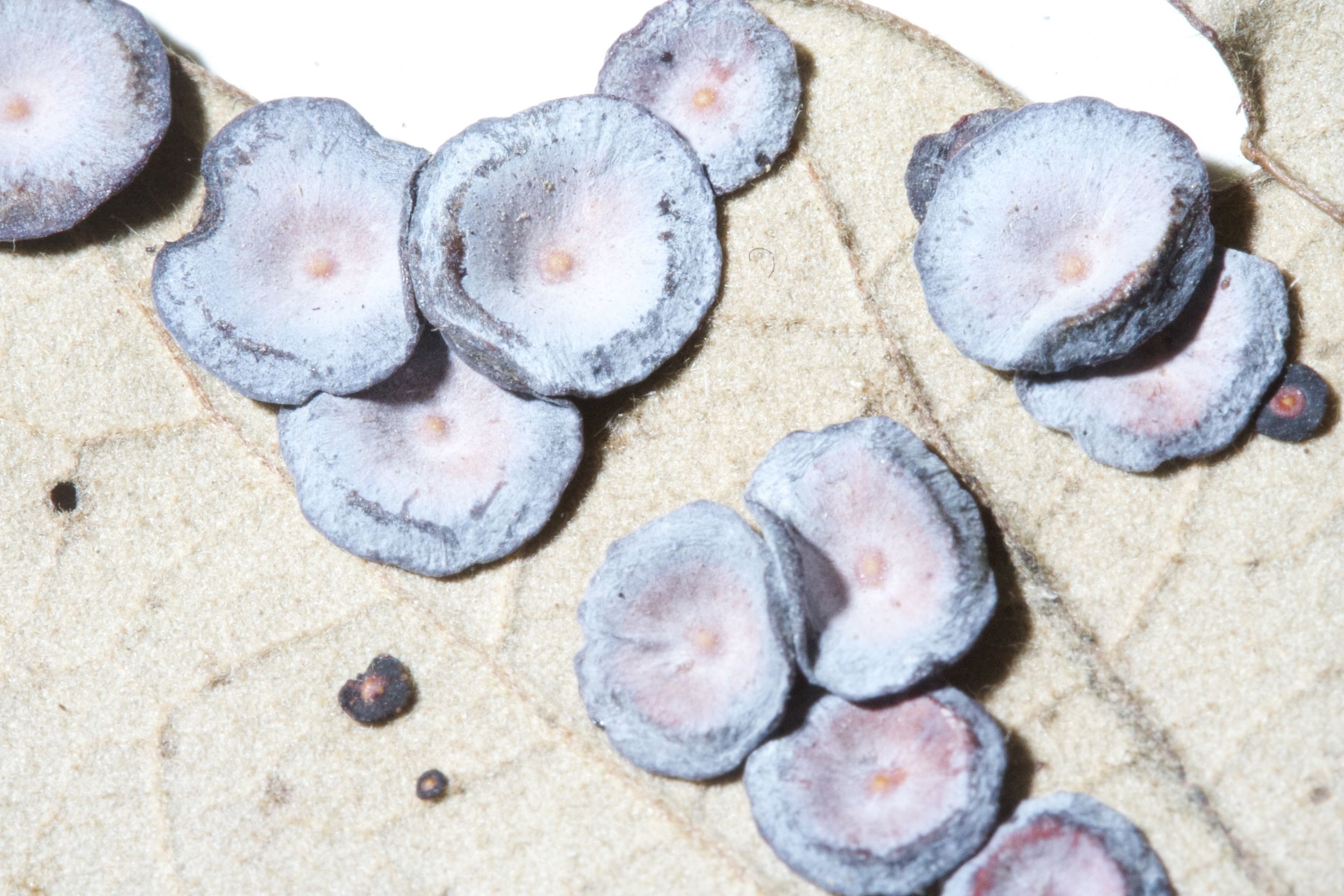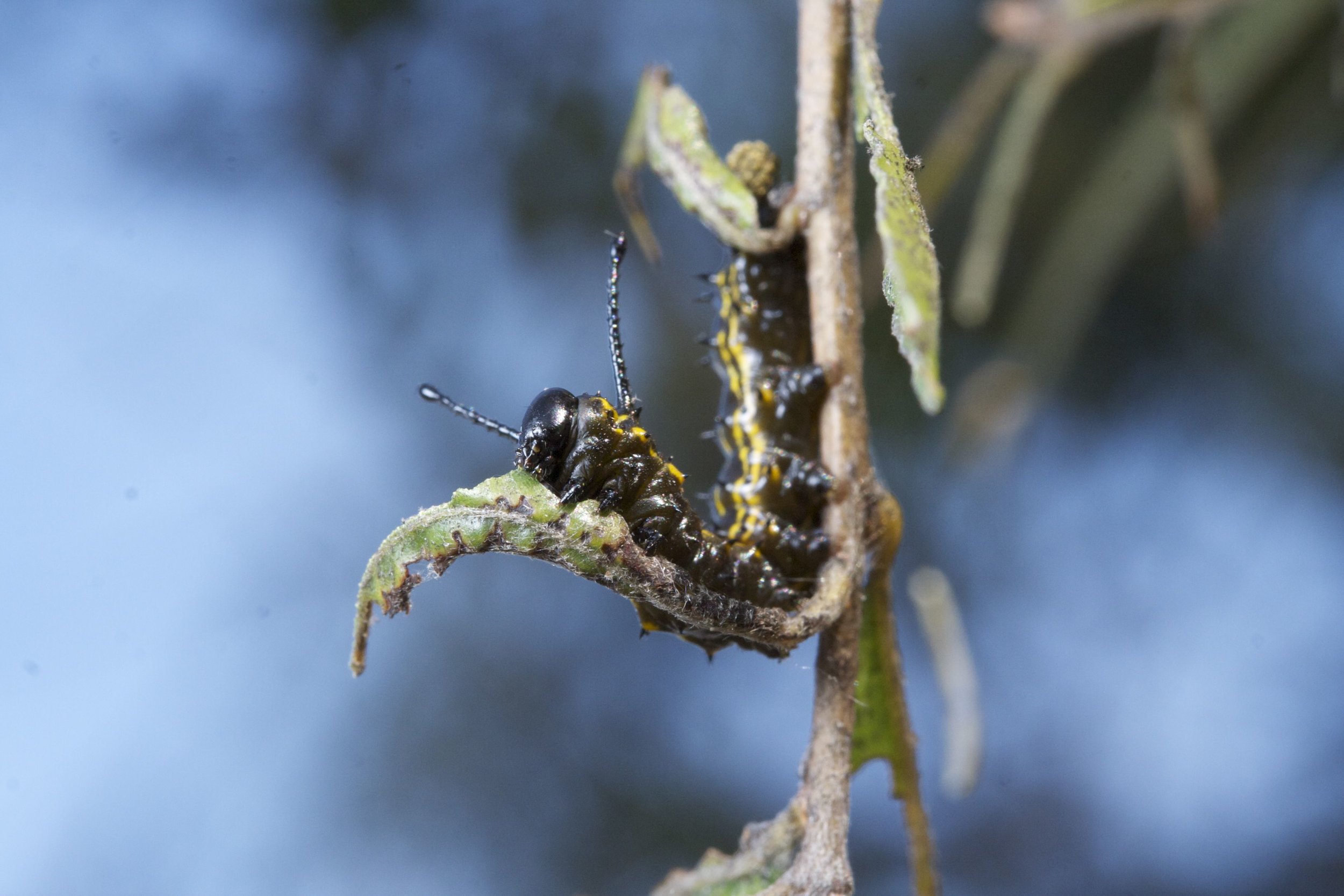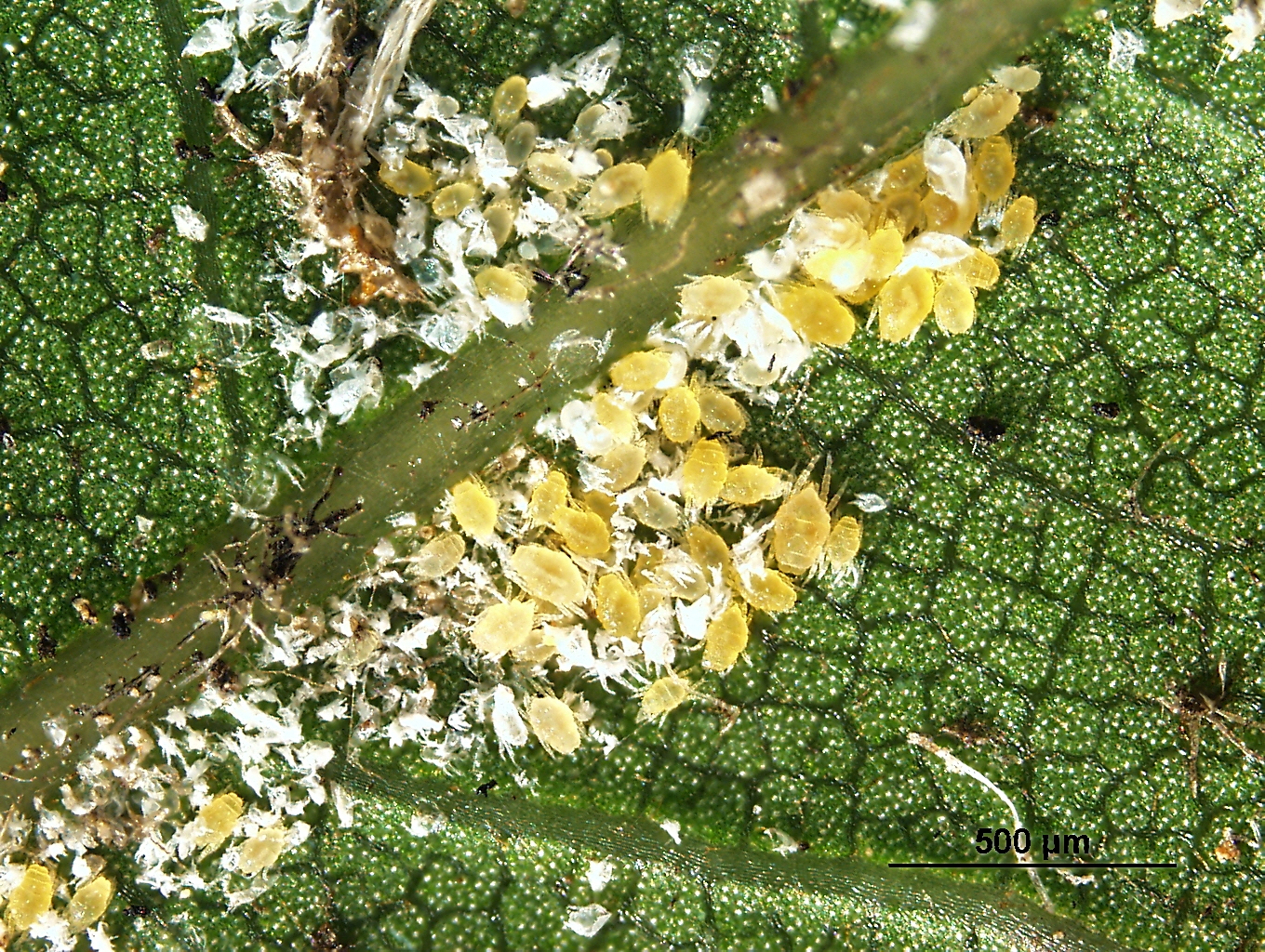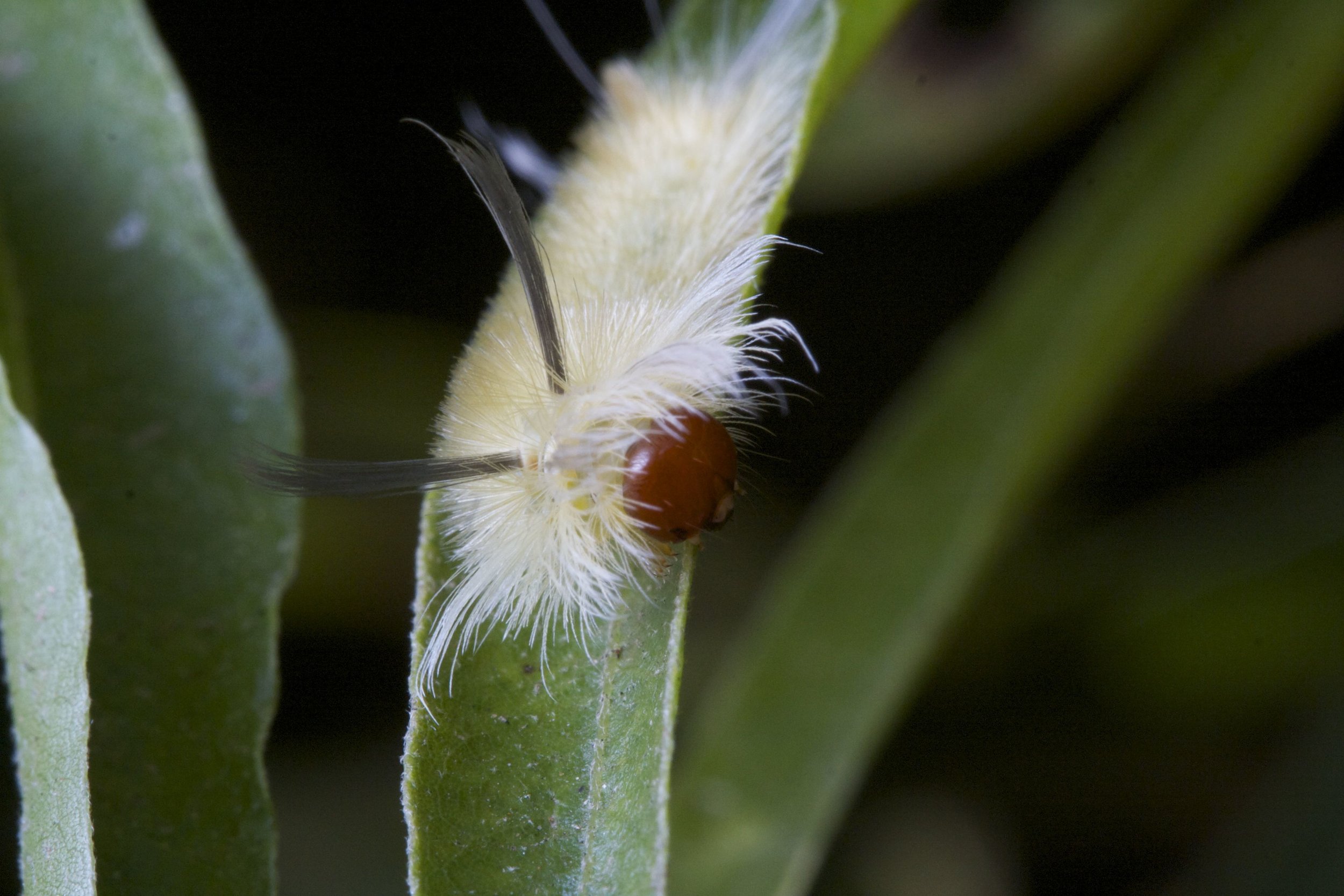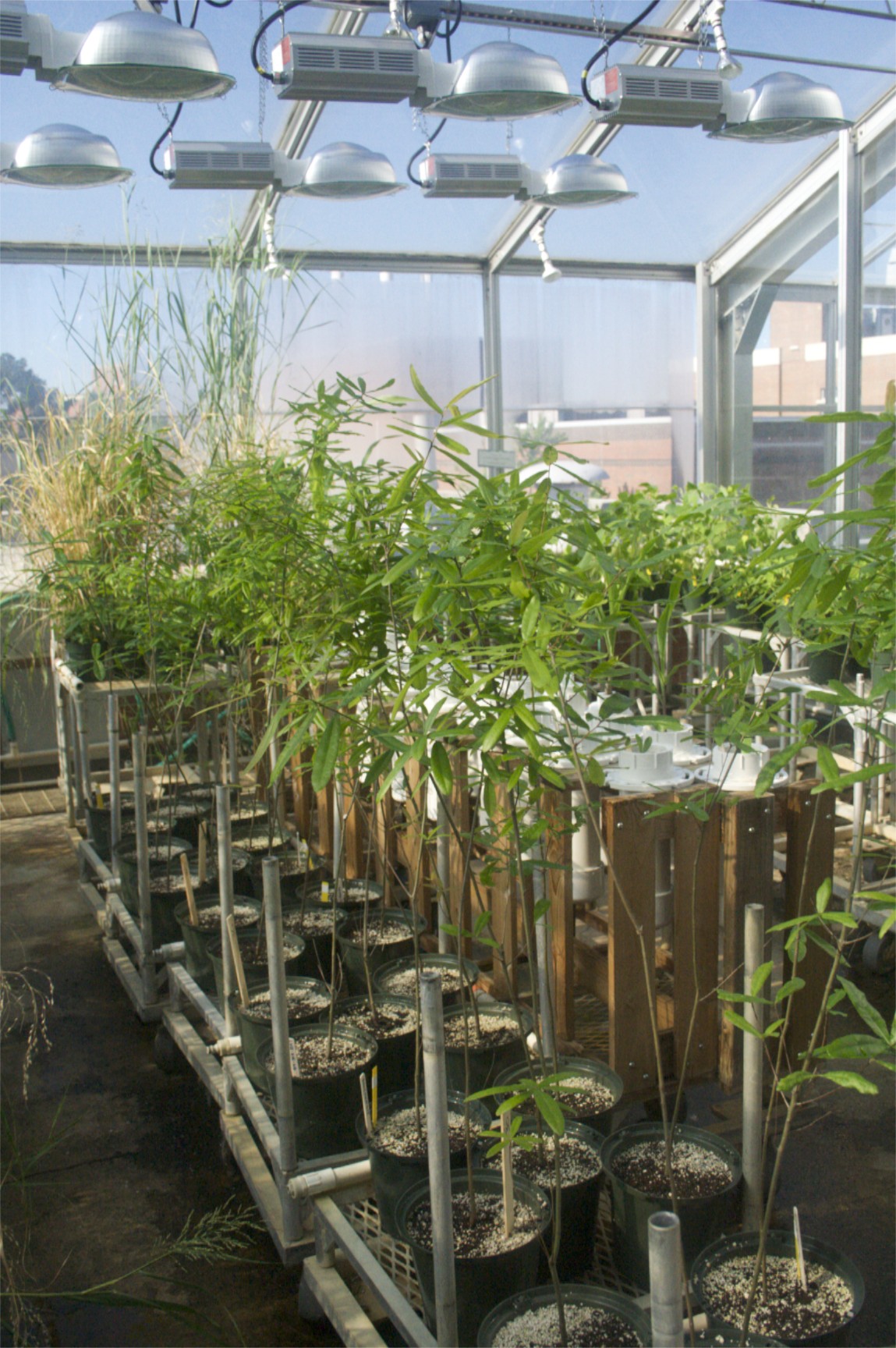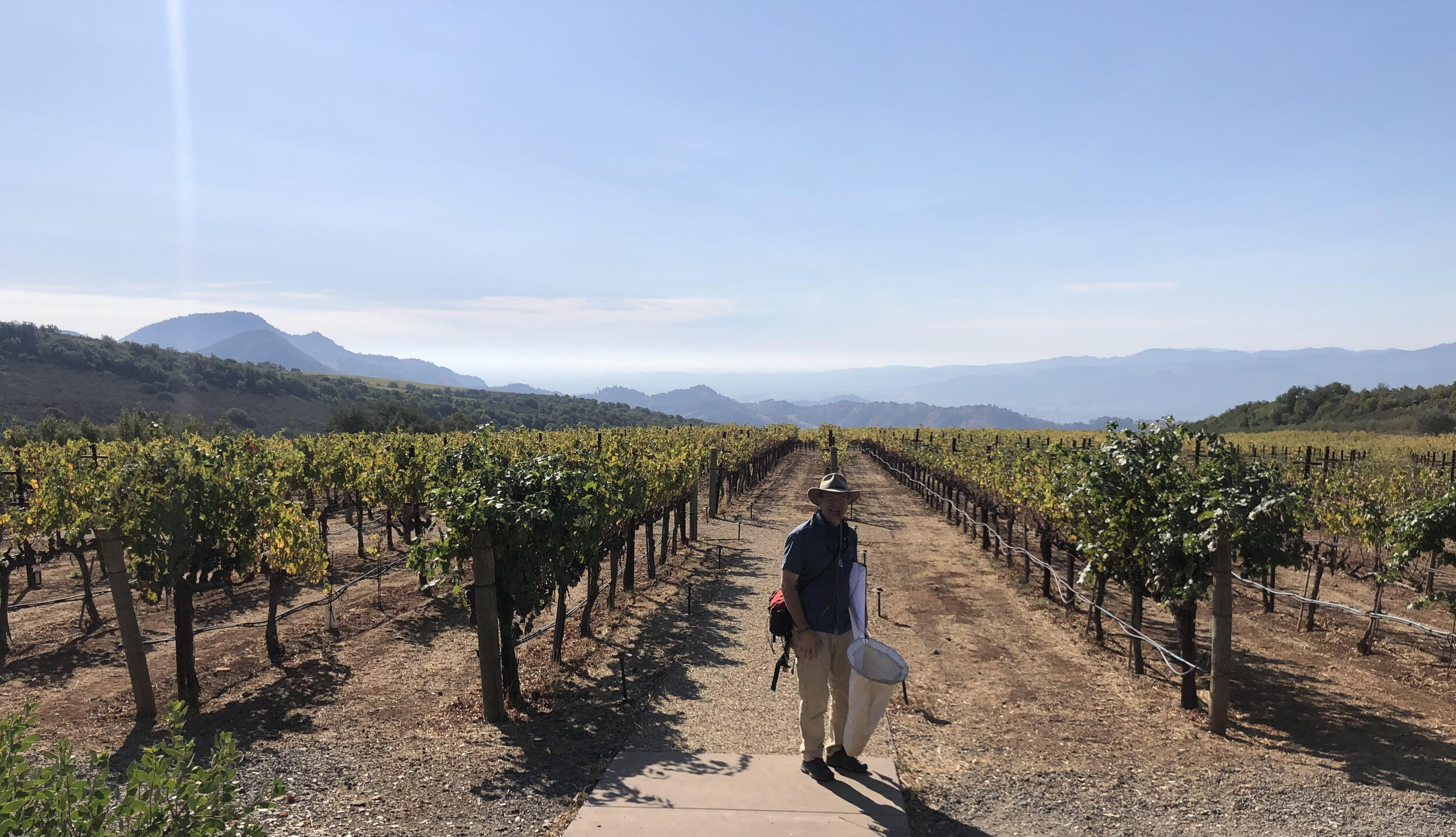Our lab investigates how human-caused global change affects plant-insect interactions.
To do so, we use observations, experiments, and historical specimens.
We harness scientific papers, conference talks, art-science fusion, and public exhibits to communicate about our changing planet.
In the context of this work, we strive to create a safe lab space where it is ok to ask vulnerable questions, share our stories, and talk about the ways in which our professional lives intersect with our personal lives. Through these conversations, we aim to build understanding among our lab members and, importantly, realistic expectations our ourselves and others.
Our lab group studies species’ responses to global change, including plant and insect physiology, phenology, and microbiomes. Though our interests are diverse, they are anchored in understanding how damage to plants has changed due to human influence. Our primary focus is damage by insect feeding damage. Herbivory has major effects on plant fitness, diversification, and management. Below are several research areas, some of which are ongoing, and some of which represent past efforts.
Herbivory through the ages: Revealing effects of global change with historical specimens (Ongoing)
Dave Barrington and I at the University of Vermont Pringle Herbarium
This figure exemplifies the timespan covered by herbarium specimens, along with the date, location, and herbivory data therein. To read the text, click on the image for a larger version.
Since at least the 1700s, scientists, including Linnaeus and Darwin, have collected herbarium specimens to describe new species, aid taxonomic classifications, and as part of regional floristic treatments. These specimens contain data recorded unintentionally by their collectors, including damage by insects and pathogens. I have been able to record data on diverse types of herbivory and lesions created by plant pathogens in a way that is replicable. Novel data derived from these methods encompass the largest temporal span of plant-herbivore interaction data during anthropogenic change.
Using these data, I showed that herbivory increased over the past century in the northeastern US. Herbarium specimens collected within the past 10 years were 23% more likely to contain damage by leaf-feeding insect herbivores than plants collected in the early 1900s. Trends across years, latitude, and temperature provided evidence that increasing herbivory is due in part to winter warming that has positive effects on insect herbivores by expanding their ranges and/or increasing their in-situ abundances.
I built a system to quantify insect damage on herbarium specimens, greatly increasing the time and spatial scales at which herbivory can be studied. This is a zoomed in section of an herbarium specimen showing insect chewing damage.
Jonathan Davies’ lab at the Harvard University Herbaria: from left to right, Max Farrell, Barnabas Daru, Jonathan Davies, Emily Meineke
The genus Protea (Proteaceae) is the focus of a collaborative project I am part of separating effects of temperature change over space and time on flowering.
Ongoing projects Now that methods have been established to quantify insect herbivory on specimens, there are endless the possibilities to apply these data to hypotheses that have been difficult to address in the past. Below are a few areas where this research is developing. The focal taxa in these projects are species of cultural or economic importance, such as forest species from Thoreau’s Woods, Cucurbita (gourds), Vaccinium (blueberries), Prunus (ornamental cherry trees), and Protea (the flagship genus of South Africa, many of which are also important ornamental cultivars):
1) Understanding the effects of phenology on herbivory: Through a cross-continental sample in the northeastern US and Europe, I found that plants whose phenology is particularly sensitive to warming are exposed to more herbivory now than in the early 1900s, whereas less sensitive plants are not. This finding indicates that plant traits (here, how sensitive leaf-out is to temperature) mediate shifting interactions with herbivores. Phenological sensitivity to temperature is generally considered beneficial to plants as the Earth warms, but this research revealed that it may have a long-term cost in the form of intensified antagonistic interactions in plants that leaf out early in response to climate change.
2) How urbanization over time affects insect chewing damage: Herbarium specimens have been disproportionately collected near roads and herbaria. As a result, they capture the effects of urbanization over time. In a project leveraging this coverage, I found that chewing herbivory is reduced in urban areas. By pairing specimen data with present-day observations of insect herbivores, I then showed that northeastern cities, and perhaps north temperate cities more generally, serve as filters for many herbivore species. Thus, while the urban heat island effect may increase abundance of certain herbivores within some cities (see below), many mandibulate herbivores, such as butterflies and moths, are excluded from urban centers. This project is expanding into plant and insect collections from Paris and Tokyo.
3) Spatiotemporal effects of temperature on plant phenology and herbivory: Because long-term data are rare, people have assessed effects of warming on various aspects of biology by studying how they shift across latitude and elevation. However, it is unclear whether temperature change over space should predict the effects of climatic warming over time. In this series of projects, I teamed up with collaborators to leverage the unique spatial and temporal coverage in herbarium specimens to determine how phenology of an iconic genus from South Africa (Protea) and phenology and herbivory of blueberry species (Vaccinium angustifolium, Vaccinium corymbosum) from the northeastern US respond to warming across time and space. These studies uniquely test in what situations we can rely on space-for-time substitutions for forecasting the effects of climate change.
EXAMPLE PAPER
Meineke, EK, Davis, CC, Davies, TJ. The unrealized potential of herbaria for global change biology. Ecological Monographs, 2018; 88(4). doi: 10.1002/ecm.1307. pdf
COLLABORATORS
Aimée Classen, Barnabas Daru, Jonathan Davies, Charles Davis, Matthew Kling, Nate Sanders, Braam Van Wyk
FUNDING
NSF Faculty Early Career Development Program (CAREER), NSF Postdoctoral Fellowship Program, NSERC CRSNG, Harvard University Herbaria
NOTE: Specimen images above and those I have posted to social media are from the Northeastern Botanical Collection's digitization project of New England plant specimens. For details about this collection, email Mikaela Schmull at mschmull@oeb.harvard.edu or see the Harvard Herbaria digitized collections.
Keeping cities green: Disentangling effects of urbanization on trees (Ongoing)
This shows the mosaic pattern of urban warming across the Raleigh, NC, USA urban heat island. The map was created from satellite measurements of surface temperature. The dots represent study sites, and their size represents insect pest abundance on street trees. Reproduced from: Meineke EK, Dunn RR, Sexton JO, and Frank SD. 2013. Urban warming drives insect pest abundance on street trees. PLoS ONE, 2013; 8 (3), doi:10.1371.journal.pone.0059687.
The Raleigh, NC, USA skyline: The largely suburban development pattern of Raleigh creates a thermal mosaic (see below), providing a built-in study system in which trees that are close together (<200 m) experience different thermal conditions.
Past project: Scale insects, parasitoids, and the future of warmer urban trees For over a century, people have wondered why plants in cities have more insect herbivores than plants of the same species living outside cities. I studied the extent to which urban warming—heat released by sidewalks, asphalt, and other hard surfaces in cities—drives this pattern by sampling insects on street trees across a gradient of urban temperatures. I found that urban warming increased abundance of a common pest known as a scale insect (Parthenolecanium quercifex) by 13 times. I also found evidence that these effects were a result of P. quercifex evolving to tolerate urban heat and disruption of its interactions with parasitoid wasps. Overall, this study revealed that insect pests and warming combined to reduce street tree growth. This work continues in Steve Frank’s lab at North Carolina State University, where it has become a major focus of research. A full summary of this work is here.
Ongoing project: Effects of vehicle pollution on insect damage to street trees We are currently investigating how vehicle traffic and urban warming affect insect herbivory on the urban trees of Sacramento, CA, USA.
Ongoing project: Urban Heat Islands As Windows Into Climate Change And Ecosystem Service Provisioning By Street Trees We are measuring a variety of traits of common urban trees across three warming cities—Sacramento, New Orleans, and Raleigh—to determine how urban heat and climate change affect shade, a key ecosystem services provided by urban trees as the climate continues to change.
PAST COLLABORATORS
Rob Dunn, Steve Frank, Elsa Youngsteadt, Anna Holmquist, Joseph Sexton
CURRENT COLLABORATORS Elizeth Cinto-Mejía, Alessandro Ossola, Mark Lubell, Rick Karban
FUNDING
USDA Foundational and Applied Science Program, EPA STAR Fellowship Program, Southeastern Climate Science Center, USGS, NSF, Garden Club of America, North Carolina State University Department of Entomology, University of California, Davis, Department of Entomology and Nemtology
EXAMPLE PAPERS
Meineke, EK, Eng, DS, Karban, R. Vehicle pollution is associated with elevated insect damage to street trees. Journal of Applied Ecology. doi: 10.1111/1365-2664.14328 pdf
Jason Bond with his spider trapping gear at Continuum Estates.
Dave Eng and Emily Meineke at Continuum Estates after we installed pitfall traps to study spiders.
Unearthing the role of spiders in vineyard ecosystems (Ongoing)
Jason Bond sampling spiders from the treetops at Continuum Estates.
Spiders are abundant predators of pest insects across many ecosystems. They are especially critical where minimizing pesticide use is a priority. As biological control agents, spiders could serve a key role in vineyards because minimizing the application of pesticides is a priority for wine producers.
However, while spiders might eat herbivorous pests, they also tend to eat each other, such that the net outcomes of spider presence on pest abundance across many systems remains unclear. In particular, the extent to which spider species feed on each other vs. pest arthropods is poorly understood. This project will address two key goals along these lines: First, we will sequence the gut contents of a wide range of spiders in vineyards to determine the extent to which particular species contribute to biological control. Second, we will determine the role of surrounding natural habitats in supporting spider populations.
COLLABORATORS
Emma Jochim, Jason Bond, James Starrett
FUNDING
USDA Hatch Program
Biological Collections for Understanding Biodiversity in the Anthropocene (Past)
I think museum specimens will be key to the next major advances in our understanding of global change, greatly expanding the spatial, taxonomic, and temporal scopes at which global change hypotheses can be addressed. I co-edited a special issue along these lines in Philosophical Transactions of the Royal Society B. This special issue, “Biological collections for understanding biodiversity in the Anthropocene” (link) brings together experts studying diverse taxa to define next generation applications of museum specimens.
COLLABORATORS
Barnabas Daru, Jonathan Davies, Charles Davis
FUNDING
NSF Postdoctoral Fellowship Program, NSERC CRSNG, Harvard University Herbaria
EXAMPLE PAPER Meineke, EK & Davies, TJ. Museum specimens provide novel insights into changing plant-herbivore interactions. Philosophical Transactions of the Royal Society B, 2019; 374: 20170393. doi: 10.1098/rstb.2017.0393. pdf
Temperature accounts for the biodiversity of a hyperdiverse group of insects in urban Los Angeles (Past)
Nine of the 30 new species of phorid flies discovered by Emily Hartop and colleagues in Los Angeles, photo reproduced from: Hartop EA, Brown BV, Disney RH. Opportunity in our ignorance: urban biodiversity study reveals 30 new species and one new Nearctic record for Megaselia (Diptera: Phoridae) in Los Angeles (California, USA). Zootaxa, 2015; 3941(4)
Within cities, areas that are warmer tend to be so because of high densities of sidewalks, pavement, buildings, and a lack of vegetation. As a result, it is impossible to separate the effects of land cover and microclimates on biotic processes. However, Los Angeles, CA, USA is unique in that land cover and microclimate are decoupled because of coastal weather patterns.
With the help of volunteers, my collaborators on this project sampled phorid flies, one of the largest, most biologically diverse families of true flies (Insecta: Diptera: Phoridae), at 30 sites distributed across the central Los Angeles (LA) Basin. They found 30 undescribed species of phorid flies in urban LA, underscoring how diverse and underexplored urban insect communities are. See examples of their news coverage here and here.
Sites across Los Angeles where volunteers placed malaise traps in their backyards to capture insect communities: The color of the dots and their size shows the non-linear relationship between phorid fly abundance and temperature.
We leveraged these data, and the fact that land cover and microclimate are uniquely decoupled in LA, to determine how these two factors affect insect communities. Abundance, richness, and community composition of phorids were most parsimoniously accounted for by mean air temperature in the week preceding sampling. Sites with intermediate mean temperatures had more phorid fly individuals and higher richness. Communities became more even with lower minimum temperatures and further away from natural areas, suggesting that communities further away from natural source populations may be more homogenized. Species composition was best explained by minimum temperature. Inasmuch as warmer areas within cities can predict future effects of climate change, phorid fly communities are likely to shift non-linearly under future climates in more natural areas. This study is the first to separate urban heat and land cover and provides evidence that heat is a key factor driving urban community assembly.
COLLABORATORS
Benjamin (‘Max’) Adams, Christie Bahlai, Brian Brown, Emily Hartop, Enjie (‘Jane’) Li, Terry McGlynn
FUNDING
LACM and its donors, The Seaver Foundation
EXAMPLE PAPER
We have a paper under review at Proceedings of the Royal Society B and another under review in Ecological Applications. Stay tuned!
Measuring microclimates: The need for standardized methods in ecology (Past)
Collaborators on this project, from left to right: Emily Meineke, Elsa Youngsteadt, Sara Prado, Adam Terando
Ecologists have recorded a lot of climate data over the past decades, mostly in an effort to understand how living things respond to climate change. Some of these observations are collected using expensive instruments that are located at permanent or semi-permanent sites. However, these weather stations are often too spread out to provide data useful for, for example, understanding temperatures experienced by frogs in a particular stream.
Instead, ecologists have increasingly turned to inexpensive data loggers to measure climate at these smaller scales. We do so with a general sense of how accurate these tools are; data loggers are tested for accuracy and precision in laboratories by the companies that make them. But ecologists deploy these tools across deserts, tropical forests, tundra, and cities, all far cries from the laboratories in which data loggers are tested. As a result, we do not know how accurate our climate data actually are.
I teamed up with other ecologists and a climatologist to address this issue. We set up a controlled experiment to test the accuracy of data loggers across forested, open field, and urban habitats. Based on our results, we provide a set of recommendations and best practices for collecting climate data in field ecology.
EXAMPLE PAPER
Terando, AJ, Youngsteadt, E, Meineke, EK, and Prado, SG. Ad hoc instrumentation methods in ecological studies produce highly biased temperature measurements. Ecology and Evolution, 2017. pdf
COLLABORATORS
Sara Prado, Adam Terando, Elsa Youngsteadt
FUNDING
Southeast Climate Science Center, USGS
Exploring the microbial communities of ant nests (Past)
Like humans, ants create built environments where they eat, live, and raise their young. Also like humans, ants are affected by the microbiomes of the their built environments. To determine the extent to which ants shape and control their home microbiomes, I teamed up with a large group of researchers across disciplines to investigate the bacterial and fungal associates in functionally distinct chambers within and outside the nests of Azteca ants inside Cecropia trees. (See the video above for more about the fascinating Cecropia-Azteca mutualism from Peter Marting, who is a collaborator on this project. Peter also took the Cecropia/Azteca photos in the gallery at the very top of this page.)
We predicted that ants maintain distinct microbiomes within their nests, and are under selective pressure to limit ant and plant pathogens. In support of these predictions, we found that internal and external nest sampling locations had distinct microbial communities, and ants maintained lower bacterial richness in their “nurseries.” Additionally, ant pathogens were suppressed in chambers that ants actively inhabited.
However, plant pathogens were not, which challenges our assumption that these mutualistic ants defend host trees from microbial antagonists. These results show that ants influence microbial communities inside their nests similar to studies on human homes. Unlike humans, ants limit the bacteria in their nurseries and prevent the buildup of insect-infecting pathogens. These results highlight the importance of documenting how indoor microbiomes differ among species, which can improve our understanding of indoor health in human dwellings.
In the future, we plan to grow Cecropia in greenhouses to further address some of the hypotheses described here. Because Cecropia is a light-loving plant genus that often occurs in urban areas, it will also provide the opportunity to investigate how urbanization affects tightly co-evolved mutualisms.
This group has another ongoing project in which we placed wooden nest boxes in Duke Forest, NC, USA to determine how temperate ants and termites structure nest microbial communities.
EXAMPLE PAPER
Lucas, JM, Madden, AA, Penick, CA, Epps, MJ, Marting, PR, Stevens, JL, Fergus, DJ, Dunn, RR, Meineke, EK. Azteca ants maintain unique microbiomes across functionally distinct nest chambers. Proceedings of the Royal Society B, 2019; 286(1908). doi: 10.1098/rspb.2019.1026. pdf
COLLABORATORS
Rob Dunn, Mary Jane Epps, Daniel Fergus, Jane Lucas, Anne Madden, Peter Marting, Clint Penick, Julia Stevens
FUNDING
NSF
